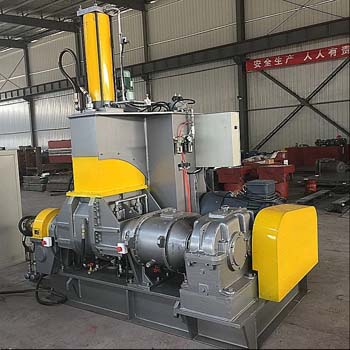Thermoplastic rubber (TPR), also known as thermoplastic elastomer (TPE), combines the processability of plastics with the elasticity of rubber. It’s widely used in shoe soles, soft-touch grips, gaskets, Sponges, Vibration Insulator, Elastic Cord, Sealing Materials and a variety of consumer and industrial goods.
To ensure consistent quality and performance, TPR compounds require precise mixing—and that’s where a dispersion kneader plays a crucial role.
A dispersion kneader is also named as internal mixer ,it is a high-performance mixing machine specially designed for compounding high-viscosity materials. This laboratory mixing kneading machine is designed for formula development and experiments in universities and research laboratories , it is applicable for TPR, natural rubber, synthetic rubber, recycled rubber ,sole, rubber roller, hoses and plastics, foamed plastics, etc .
The laboratory dispersion kneader machine come with two rotating cyclinder rotors inside a closed mixing chamber.
When working, this pair of Z-shaped blades rotating in opposite directions at different speeds,which generate strong shear ,blend and kneading forces to disperse compound material, like TPR, chemical ,polymers and additives, so that mix material evenly and uniformly and ensure homogeneous compound dispersion, easy colour change for TPR formulations.
So Why Use a Dispersion Kneader for TPR Material?
1. Consistent Mixing Quality
TPR material requires a uniform dispersion of rubber, chemical ,polymer, color masterbatch ,plastic resins, fillers, and plasticizers. The dispersion kneader equipment provides a controlled environment that ensures excellent mixing without material degradation.
2. Temperature Control
As TPR processing is sensitive to temperature. Thus the kneader’s jacketed chamber and rotor cooling system are great to help maintain ideal thermal conditions, which avoid scorching or premature melting.
3. Efficient Gelation and Homogenization
The shear force generated by this pair count rotors inside the kneader chamber helps properly gel the rubber phase and blend it evenly with the thermoplastic matrix.
4. High Viscosity Handling
TPR materials often have high viscosity during processing. Thus laboratory dispersion kneaders machine are specifically built to handle such materials with ease.
5. Lab and Production Scalability
Laboratory dispersion kneaders are perfect for R&D and pilot-scale formulation of TPR compounds. The data and results can be scaled up to larger production mixers.
* Common TPR Compounds Processed
* Styrene-based TPR (SBS, SEBS, SIS)
* Olefin-based TPR (TPO)
* Urethane-based TPEs
* Custom TPR blends for footwear, grips, and automotive parts
Whether you’re developing a new TPR grade or fine-tuning an existing formulation, a dispersion kneader equipment is ideal laboratory equipment for consistent, high-quality mixing. With precise temperature control and robust shearing action, the dispersion kneader machine ensures reliable results in every batch—which make it an indispensable tool for polymer compounding labs and manufacturers alike.







